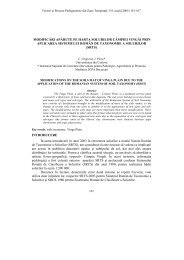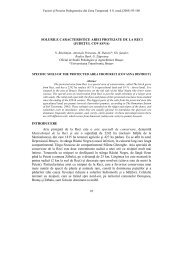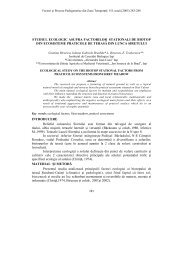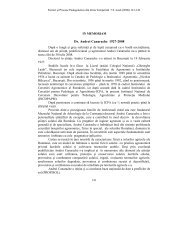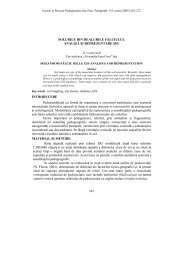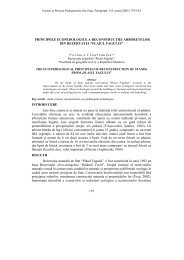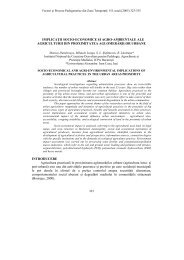THE LOESS FROM ROMANIA IN THE ROMANIAN ... - Soil Science
THE LOESS FROM ROMANIA IN THE ROMANIAN ... - Soil Science
THE LOESS FROM ROMANIA IN THE ROMANIAN ... - Soil Science
You also want an ePaper? Increase the reach of your titles
YUMPU automatically turns print PDFs into web optimized ePapers that Google loves.
Factori şi Procese Pedogenetice din Zona Temperată 5 S. nouă (2006) 103-116<br />
<strong>THE</strong> <strong>LOESS</strong> <strong>FROM</strong> <strong>ROMANIA</strong> <strong>IN</strong> <strong>THE</strong> <strong>ROMANIA</strong>N SPECIALISTS<br />
VISION<br />
Alina Gherghina, Florina Grecu*, Valentina Coteţ<br />
National Institute of Research-Development for Pedology, Agrochemistry and Environment<br />
Protection (ICPA), Bucharest<br />
* University of Bucharest, Faculty of Geography, Geomorphology-Pedology Department<br />
<strong>LOESS</strong>UL D<strong>IN</strong> ROMÂNIA <strong>IN</strong> VIZIUNEA SPECIALIŞTILOR ROMÂNI<br />
Abstract<br />
As a lithological formation, the loess was for the first time mentioned in the geological<br />
works of the 19 century (the first Romanian describe of the loess deposits was given by Gr.<br />
Stefanescu in 1895 and the aeolian origin of the loess was stated for the first time in our country by<br />
L. Mrazec, in 1899).<br />
According to Em. Protopopescu-Pache et. al (1966), the loess deposits covers an area of<br />
40 000 km 2 , dispersed on the interfluves and the terrace bridges in the peri-carpathian regions<br />
(especially in the Romanian Plain and Dobrogea), at which are added some terraces and some<br />
weakly inclined slopes from the sub-carpathian region, Transylvanian Plateau and the<br />
intramontanian depression.<br />
Both in the first studies (Mrazec L. 1899, Murgoci et al 1908) and in those published<br />
between the two World Wars was agreed the aeolian origin of the loess and the fossil soils received<br />
a stratigraphyc value.<br />
After the two World War, the loess study (as quaternary deposit) was approached by<br />
researchers from different domains: hydrogeology, pedology and geography, who emitted different<br />
assumptions of the loess origin (aeolian, deluvial or alluvial – the loessic features of the material<br />
being considered as a result of a postsedimentary diagenesis process) and contribute to the<br />
knowledge and the characterization of the loess from Romania.<br />
Key words: loess, Romania, romanian specialists.<br />
<strong>IN</strong>TRODUCTION<br />
As lithological formation, the loess it was mentioned for the first time in our<br />
country in the geological papers from the XIX th century. Thus, the first descriptions of<br />
the loess deposits from Romania were given by Gr. Stefanescu, in 1895, in the paper<br />
Relation sommaire sur la structure geologique dans les jud. de Tutova, Fălciu,<br />
Covurlui, Ialomiţa et Ilfov, (Anu. Muz. Geol. şi paleont.). The following studies,<br />
undertaken by researchers from different scientific areas, brought significant<br />
contributions at knowledge of the loess from our country.<br />
103
A. Gherghina et.al. / Factori şi Procese Pedogenetice din Zona Temperată 5 S. nouă (2006) 103-116<br />
In this paper, we propose to resume some of the most representatives<br />
contributions, on periods and scientific areas and to present a brief description of the<br />
loess and loess-like deposits from Romania (texture, origin, age, extension).<br />
MA<strong>IN</strong> <strong>THE</strong>MES<br />
Aeolian origin of the loess from Romania was sustained for the first time by L.<br />
Mrazec, in 1899, in paper Comunicare asupra loessului din Romania.<br />
The bases of the loess and paleosoils studies there have been set, at the<br />
beginning of the XX th century, by Gh. Murgoci and his contributors, Emm.<br />
Protopopescu-Pache and P. Enculescu (1908, 1910). They were sustained the aeolian<br />
origin of the loess (the sources were, at last for the eastern part of the Romanian Plain,<br />
the alluvia of the rivers which cross the plain), they shown that the red layers from<br />
loess are paleosoils and, by analyze of those, “we could deduce the climatic changes<br />
from Romania from the age of the loess sedimentation”.<br />
In the same period, R. Sevastos (1908) studied the loess from Moldavia,<br />
consider that it is aeolian deposit formed by sedimentation of the dust brought by<br />
winds from Asiatic deserts or from the north-European ice fields, and Simionescu I.<br />
(1903) shown that in Moldavia between Siret and Prut rivers, the loess-like deposits<br />
have alluvial origin (there are formed in the same period with melting of the north-<br />
European ice-sheet).<br />
After the establishment of the International Union of Quaternary Research<br />
(<strong>IN</strong>QUA), in 1928, which consisted many commissions, among them Commission on<br />
Quaternary Stratigraphy included and the study of the loess, on international plain and<br />
in our country there have been intensified studies of that deposits.<br />
Thus, there have been made detailed studies of the loess profiles and<br />
paleosoils, through which we remark N. Florov papers (1927, 1930) – studies in the<br />
Black See steppes – and those of C. Bratescu (1935, 1937, 1942) – which gave the<br />
paleosoils stratigraphyc value: the number of the loess layers indicate the number of<br />
the glacial periods, and the number of the paleosoils give the number of the interglacial<br />
periods.<br />
Emm. Protopopescu-Pache made the first synthesis map of the Pleistocene<br />
deposits, sustained at the III th Conference of International Association of Quaternary,<br />
Viena, 1936. This map was used like base for the geological map of Romania, scale 1:<br />
500.000 (1936-1958). In the same period, were made analysis on mechanical, chemical<br />
and mineralogical composition of the loess, by S. Gogalniceanu (1937); M. Popovat<br />
(1937, 1938) a.s.o<br />
At the first meeting on loess, organized at the VI th Congress of <strong>IN</strong>QUA, in<br />
1961, in Lublin, Poland, it was organized the Commission for stratigraphy of the loess<br />
from Europe, with annual/biannual meetings (field trips) in different European<br />
countries, among them and Romania, in 1972. In 1965, in Hungary, it was proposed to<br />
research the loess types from Europe and to achieve of a map at scale 1:25.000.000;<br />
this map contained 8 categories of loess, with many types, among them, in category<br />
meadow (alluvial) loess-like deposits in was included and the type loess baragan,<br />
particular for Romania.<br />
104
A. Gherghina et.al. / Factori şi Procese Pedogenetice din Zona Temperată 5 S. nouă (2006) 103-116<br />
Because of the amplitude of the European and global research on the loess and<br />
of the importance of this rock (as parental material for the soils and as base for human<br />
activity and buildings), the study of loess developed new perspectives and new<br />
domains (hydrogeology, geology, pedology, geography, geomorphology, archaeology,<br />
buildings) in our country.<br />
a) Hydrogeological researches there have been made at the Hydrogeological<br />
department of the National Geologic Committee, leadership by E. Liteanu. There have<br />
been written many papers about the Quaternary period from different subunits of the<br />
Romanian Plain, and about loess and loess-like deposits: T. Bandrabur, 1961, 1966,<br />
1971; E. Liteanu, 1952, 1953, 1956, 1957, 1961; E. Liteanu, C. Ghenea, 1966; Al.<br />
Obreja, 1960. Besides, it was drawn a map of the quaternary, at scale 1:1.000.000 (E.<br />
Liteanu et. al., 1964). All those mentioned above sustained the deluvial origin of the<br />
loess-like deposits; after deposition, the materials took the loess characteristics, caused<br />
by diagenetic processes.<br />
b) Geology. At the “Prospectiuni” department of Geological Institute, there<br />
have been made detailed mineralogical studies about loess and loess-like deposits from<br />
Romanian Plain and Dobrogea: Venera Codarcea, 1980; Venera Codarcea, T.<br />
Bandrabur, 1976, 1984; Venera Codarcea, C. Ghenea, 1975, 1976; C. Ghenea, Venera<br />
Codarcea, 1974, 1979 a.s.o.<br />
c) Pedology. The pedologists made detailed descriptions of some loess –<br />
paleosoils sequences: Ana Conea at al. in Romanian Plain and Dobrogea; N. Florea et.<br />
al., 1966, at Semlac, Tisa Plain; N. Florea et. al., 1989, in Pitesti Plain; M. Popovat<br />
(1938, 1944, 1953, 1957, 1964) in Baragan, Dobrogea and Oltenia. Also, there were<br />
made the mechanic, chemical and mineralogical studies: N. Cernescu, 1952; M.<br />
Popovat, 1937; Tatiana Postolache, 1966 a.s.o.<br />
Ana Conea (1968) achieved the first and the only, since now, PhD thesis in this<br />
study area, in our country, about the loess deposits from the Central and South<br />
Dobrogea, paper published in 1970.<br />
d) Geography. The geographical studies were focused on the following<br />
directions:<br />
- Descriptions of the processes and the microforms developed on loess: P.<br />
Cotet, 1964; N. Florea, 1970; T. Morariu, 1946; T. Morariu, V. Tufescu, 1964; V.<br />
Tufescu, 1959 a.s.o.<br />
- Contributions to the knowledge of the loess and loess-like deposits within the<br />
framework of some geomorphological and geographical studies from different areas,<br />
the most of them PhD thesis: I. Donisa (1968 – the Bistrita Valley); M. Ielenicz (1988<br />
– Dobrogea); N. Mihaila (1957 – the West Plain; 1974 – the Fagaras Depression); V.<br />
Sficlea (1972 – the Covurlui Platform); I. Sarcu (1953 – the Poiana Nicorasti<br />
Piedmont); G. Valsan (1916 – the Romanian Plain) a.s.o.<br />
- Descriptions of some loess profiles: N. Bucur, N. Barbu, 1956, 1959, 1960; P.<br />
Cotet, 1966; P. Cotet et. al., 1957, 1960; C. V. Oprea, A. Contrea, 1956; Gr. Posea,<br />
1962.<br />
105
A. Gherghina et.al. / Factori şi Procese Pedogenetice din Zona Temperată 5 S. nouă (2006) 103-116<br />
e) Archeology: applied of the archeological method in the loess study: M.<br />
Popovat, C. Nicolaescu-Plopisor, M. Spirescu, 1957; archeological studies: Paunescu,<br />
Bitiri a.s.o.<br />
f) Buildings: problems arisen from usage of the loess deposits in the civil<br />
buildings: R. J. Bally, 1972; R. J. Bally, I. Antonescu, 1971; R. Bally, P. Stănescu,<br />
1971; Vaicum A. 1988; or from implement of the landed improvements: M. Botzan,<br />
1956; M. Botzan, C. Haret, N. Petrescu, O. Merculiev, 1959; Dron A., 1976.<br />
After 1985, there have been made few studies concerning the loess and loesslike<br />
deposits and there were achieved especially by pedologists (N. Florea, I. Munteanu<br />
et.al.) and geologists (C. Panaiotu, Sanda Balescu). From the most important papers,<br />
we signaled those by I. Munteanu et. al., 1997, who applied the method of radiocarbon<br />
dating for some soils and parent materials from the Romanian Plain, their result<br />
sustaining the aeolian acretion theory for the loess deposit from the eastern part of the<br />
Romanian Plain, and by N. Florea and M. Mihalache, 2005, who accomplished an<br />
pattern of the cycle evolution for the loess and paleosoil sequences.<br />
The geologist applied new methods for the research of the loess and loess-like<br />
deposits: paleomagnetism (Panaiotu et. al., 2001) and luminescence dating (Sanda<br />
Balescuet. Al., 2003).<br />
The knowledge about the loess deposits from Romania is completed with<br />
synthesis papers and universitary courses.<br />
From the synthesis papers we mention: P. Enculescu (1929), O. Herşcovici<br />
(1970), M. Popovăţ (1937), E. Protopopescu-Pache, F. Crăciun, D. Popescu (1966),<br />
Em. Protopopescu-Pache, M. Spirescu (1963), M. Spirescu (1970), D. Teaci (1957), V.<br />
Tufescu (1942).<br />
The universitary courses treated quaternary deposits (Florina Grecu, 1997,<br />
Florina Grecu, T. Demeter 1997), or the Quaternary period: I. Donisă (1993), N.<br />
Macarovici (1968), N. Mezarosz (1990).<br />
<strong>THE</strong> <strong>LOESS</strong> AND <strong>LOESS</strong>-LIKE DEPOSITS CHARACTERISTICS<br />
In the studies published in the first half of the last century there have been<br />
made no differences between loess and loess-like deposits, but there were often used<br />
the both terms for deposits with different textures. Liteanu and his contributors used,<br />
for the deposits from the Romanian Plain, only the term loess-like deposits, with<br />
different mechanical composition. Ana Conea, Nadia Ghiţulescu, P. Vasilescu (1963)<br />
made an paralleled description of the loess and loess-like deposits, which we resume<br />
below:<br />
The loess:<br />
- unconsolidated, yellow, unstratificated and uniform rock;<br />
- silty texture (with prevalent 0,05-0,01 mm elements), and without coarse<br />
elements;<br />
- high porosity (40-50%);<br />
- with very low or without plasticity;<br />
- carbonates equal dispersed in rock and precipitate as limes concretions;<br />
106
A. Gherghina et.al. / Factori şi Procese Pedogenetice din Zona Temperată 5 S. nouă (2006) 103-116<br />
- favorise the subsidence and is easily to erodate.<br />
The loess-like deposits:<br />
- unconsolidated rocks, with different colors, sometimes with stratifications<br />
and various uniformity;<br />
- different mechanical composition (loamy sand-silt-clay), with coarse sand<br />
and/or gravel;<br />
- various porosity, generally low;<br />
- various plasticity, depending on mechanical composition;<br />
- carbonates dispersed;<br />
- the subsidence and the compaction processes are nor characteristics;<br />
- they could be quickly and radical transformed by subsidiary processes.<br />
<strong>THE</strong> TEXTURE OF <strong>THE</strong> <strong>LOESS</strong> AND <strong>LOESS</strong>-LIKE DEPOSITS<br />
As in the whole world in our country to the loess has loamy texture. M.<br />
Popovat (1936) ascribe for the loess from Romania a percentual composition, presented<br />
below:<br />
Fractions<br />
Grain’s diameter Extreme values<br />
Medium<br />
(mm)<br />
% values<br />
%<br />
Coarse sand<br />
2-1 - -<br />
1-0,5 - -<br />
Medium sand<br />
0,5-0,2 0-1,7 0,7<br />
0,2-0,1 0,5-5 2,4<br />
Fine sand<br />
0,1-0,05 2,5-17 10,0<br />
0,05-0,02 30-55 41,5<br />
Silt and clay < 0,02 30-55 45,4<br />
By E. Protopopescu-Pache, F. Crăciun, D. Popescu (1966), the loess has more<br />
than 60% particles between 0,01 and 0,1 mm and loess-like deposits have less than<br />
60% of that particles.<br />
In time, there were made textural analyses for the loess and loess-like deposits<br />
from main regions of the country and stated that the loess from Romania is similar, as<br />
concern the mechanical composition, with that from Eastern and Central Europe.<br />
<strong>THE</strong> GENESIS OF <strong>THE</strong> <strong>LOESS</strong> AND <strong>LOESS</strong>-LIKE DEPOSITS<br />
The aeolian origin of the loess was sustained and, generally accepted, both in<br />
the studies from the end of the XIX th century and in those from the first part of the<br />
XX th . The main sources of dust were the southern steppes of Russia (Mrazec, 1899) or<br />
the meadows (alluvial plains) of the narrow rivers (Murgoci et. al., 1910).<br />
After 1950, due to the intensification and diversification of the studies about<br />
loess, new theories on its origin have arisen.<br />
The regional researches helped for a good knowledge of the loess and loesslike<br />
deposits characteristics and evidenced that not a single agent (the wind) generated<br />
107
A. Gherghina et.al. / Factori şi Procese Pedogenetice din Zona Temperată 5 S. nouă (2006) 103-116<br />
this rocks in the whole country, but, depending on the local conditions, the genesis<br />
could by complex.<br />
The hydrogeologists (E. Liteanu, 1952, 1953, 1957, 1961) asserted the deluvial<br />
origin, after deposition materials being transformed in loess, by diagenetic processes.<br />
The deluvial-proluvial origin was stated for the north and the southwestern part<br />
of the Eastern Romanian Plain (E. Liteanu, 1957. 1961), for the Moldavian Subcarpati<br />
(Bucur N., Barbu N., 1959), the Western Plain (the part of the south of the Mures river<br />
– N. Mihăilă 1957, C. Ghenea 1966) and in other regions.<br />
Venera Codarcea, T. Brandabur, 1984, for the Eastern Romanian Plain,<br />
asserted the alluvial origin, the sources of the materials being considered the mio-pliopleistocene<br />
sediments from Subcarpati, bringing by the carpathian rivers.<br />
The aeolian origin was accepted further on by Ana Conea and her contributors<br />
for the Eastern Romanian Plain and Dobrogea, by I. Sircu, 1953 for the southern part of<br />
the Moldavian Plateau, by I. Sumeghy, 1944 for the Western Plain, at south of the<br />
Mures river a.s.o.<br />
The loessification theory (transformation by diagenetic processes of the<br />
materials with different genesis in loess) was asserted by N. Bucur, N. Barbu, 1959, for<br />
the loess from Moldova and by C.V. Oprea, A. Contrea, 1956 for de Western Plain, at<br />
north of the Mures river.<br />
The aeolian accretion theory is asserted by N. Florea and different contributors,<br />
in the basis of some regional researches (Semlac, Tisa Plain, 1966, Piteşti Plain, 1989).<br />
The theory consist in addition in soil, by pedogenetic processes, of the aeolian<br />
particles; this processes proceed and in the present.<br />
<strong>THE</strong> AGE OF <strong>THE</strong> <strong>LOESS</strong> AND <strong>LOESS</strong>-LIKE DEPOSITS<br />
For knowledge the age of the loess and loess-like deposits from Romania, there<br />
have been used in time different methods, namely: references to some gravel or alluvial<br />
sand layers in that there were found palaeontological proves (E. Liteanu, T. Bandrabur,<br />
1957, T. Bandrabur, 1971); correlations between quaternary climatic oscillations and<br />
the number of the loess and paleosoils layers (Gh. Munteanu-Murgoci, 1910, C.<br />
Brătescu, 1934, 1937, M. Popovăţ et. al., 1964, P. Coteţ, 1957, Gr. Posea, 1961, Ana<br />
Conea, 1970); pollen analysis (Violeta Iliescu, C. Ghenea, 1964, Violeta Iliescu,<br />
Gianina Cioflica, 1964, N. Florea et. al., 1965); archeological methods (traces of<br />
human activity in loess – I. Donisă, 1968, a.s.o.).<br />
Nowadays, the age of the loess and loess-like deposits is considered medium<br />
Pleistocene in the Oltenia Plain (T. Bandrabur, 1971) and parts of the Covurlui Plateau<br />
(V. Sficlea, 1972) and Dobrogea (Ana Conea, 1970) and upper Pleistocene for the<br />
other regions, even lower Holocene for the younger terraces.<br />
<strong>THE</strong> EXTENT OF <strong>THE</strong> <strong>LOESS</strong> AND <strong>LOESS</strong>-LIKE DEPOSITS<br />
By E. Protopopescu-Pache, F. Crăciun, D. Popescu, 1966, the area occupied by<br />
the loess and loess-like deposits is about 40.000 km² and is spread on the interfluves<br />
and the top of the terraces from pericarpathian regions: the Romanian Plain, Dobrogea,<br />
108
A. Gherghina et.al. / Factori şi Procese Pedogenetice din Zona Temperată 5 S. nouă (2006) 103-116<br />
Getic Plateau, Moldavia, the West Plain. To this there are added the loess-like deposits<br />
on some terraces or slopes from Subcarpathian Hills, Transilvanian Plateau and some<br />
intramontanian depressions.<br />
We present, further on, a brief characterization of these deposits:<br />
Romanian Plain:<br />
• Eastern Romanian Plain: typical Aeolian loess, proceeded from alluvial meadows<br />
(Murgoci, 1910, Conea et. al., 1963). By E. Liteanu, the origin of deposits is aeolian in<br />
the eastern part, alluvial (lacustric) in the center and deluvial-proluvial in north and<br />
north-east, and by Codarcea Venera şi Bandrabur T. 1984, the origin is alluvial.<br />
• The Central part of the Romanian Plain: loess and loess-like deposits with<br />
different texture and alluvial and proluvial genesis (aeolian in the eastern and western<br />
extremities, by Ana Conea et. al., 1970.<br />
• Oltenia Plain: loess-like deposits with loamy texture and complex genesis:<br />
deluvial, alluvial, aeolian and, local, lacustric.<br />
The Getic Plateau: loess-like deposits with different texture and genesis:<br />
deluvial-aeolian on interfluves, deluvial-alluvial on terraces, Aeolian on upper terraces.<br />
Dobrogea: typical loess with paleosoils on interfluves, loess-like deposits<br />
reworked on slopes and depressions; Aeolian origin on southern interfluves, deluvialaeolian<br />
on slopes in north and center and eluvial-deluvial on terraces (Ana Conea, C<br />
Ghenea, Venera Codarcea, 1979).<br />
Moldavia: Aeolian loess in south (I. Sircu, 1953), loess-like deposits (formed in<br />
situ, by diagenesis) in Jijia Plain; alluvial loess-like deposits on terraces, loess-like<br />
deposits proceeded from marls on interfluves (N. Bucur, N. Barbu, 1959), deluvialproluvial<br />
deposits in Subcarpate Hills.<br />
The West Plain: loess at south of the Mures river, aeolian by I. Sumeghy, 1944,<br />
proluvial-deluvial by N. Mihaila, 1957, C. Ghenea, 1966; lehm and sandy loess at north<br />
of the Mures river, resulted by transformation of the alluvial deposits (C. V. Oprea, A.<br />
Contrea, 1956).<br />
Other regions: Transilvanian Plateau, Brasov Depression, Curbura Subcarpatian<br />
Hills a.s.o: loess-like deposits with different texture and complex genesis: alluvial,<br />
proluvial-coluvial, aeolian.<br />
CONCLUSIONS<br />
The researches on loess and loess-like deposits from Romania begun at the end<br />
of the XIX th century with paper “Relation sommaire sur la structure geologique dans<br />
les jud. de Tutova, Fălciu, Covurlui, Ialomiţa et Ilfov, “, by Gr. Stefanescu. The<br />
complex studies achieved in time, at macro- and micro-regional level covered many<br />
themes and leaded to knowledge of the loess and loess-like deposit characteristics and<br />
extent. All these required further researches, based on new methods used on<br />
international level and correlations with traditional methods.<br />
REFERENCES<br />
ALIMĂNIŞTEANU C. 1896, Sondajul din Bărăgan, BSG, Rom, Bucureşti<br />
109
A. Gherghina et.al. / Factori şi Procese Pedogenetice din Zona Temperată 5 S. nouă (2006) 103-116<br />
ANDREI G.,1971, Câteva consideraţii asupra formării şi evoluţiei crovurilor din<br />
sudul Câmpiei Române, STE, C, 19<br />
APOSTOL L., 1985, Les depots quaternaires du sud-est de la Plaine Roumaine et leur<br />
importance pour les etudes paleogeographiques, Trav. Mus. d’Hist. Nat. „Gr.<br />
Antipa”, XXVII.<br />
ARGETOAIA I., MURGOCI G. M., 1923, Cuaternarul în Oltenia, D. d. S. Inst. Geol.,<br />
VI, (1914-1912), Bucureşti<br />
ATHANASIU S., 1941, PRIVIRE GENERALĂ ASUPRA GEOLOGIEI DOBROGEI,<br />
SGDCI, III<br />
BALLY R. J. 1972, Problems of loess deposits in civil engineering in Romania, Guid<br />
to Excursion, Geol. Inst, 10, Bucureşti<br />
BALLY R. J., ANTONESCU I., 1971, Loessial soils in Civil Engineering (in<br />
Romanian), Edit. Tehnică, Bucureşti<br />
BALLY R., STĂNESCU P., 1971, Unele aspecte ale deformării masivelor de loess<br />
sensibile la umezire, Edit. Ceres, Bucureşti<br />
BANDRABUR T. 1961, Cercetări hidrogeologice pe interfluviul Ialomiţa-Mostiştea-<br />
Dunăre, STE, E, 5, Bucureşti<br />
BANDRABUR T. ,1966, Precizări privind poziţia stratigrafică şi vârsta nisipurilor de<br />
Mostiştea, D. d. S. Inst. Geol, LII, Bucureşti<br />
BANDRABUR T. ,1971, Geologia Câmpiei Dunărene dintre Jiu şi Olt, STE, J, 9,<br />
Bucureşti<br />
BANDRABUR T., FERU M., OPRAN C., 1963, Cercetări geologice şi hidrogeologice<br />
în regiunea dunăreană dintre Jiu şi Călmăţui, STE-IG-E, 6<br />
BARAT C. ,1960, Profil geologique et donnees paleontologiques de la terasse du<br />
Colentina ou nord-ouest de Bucarest, Trav. Mus. d’ Hist. Nat. „Gr. Antipa”,<br />
Bucureşti<br />
BASARABEANU N. ,1978, Tasarea naturală şi accelerată a depozitelor loessoide din<br />
Podişul Medgidia, St. geogr., TUB<br />
BALESCU SANDA, LAMO<strong>THE</strong> M., MERCIER N., HOUT S., BALTEANU D.,<br />
BILLARD A., HUS J. ,2003, Luminescence chronology of Pleistocene loess<br />
deposits from Romania: testing methods of age correction for anomalous<br />
fading in alkali feldspars, Quaternary <strong>Science</strong> Reviews, 22, 967-973<br />
BOTZAN M., 1956, La deformation de certains ouvrages hydrotechniques par siute du<br />
tassement du substratum loessoide, VI-e Congres Internat. De la <strong>Science</strong> du<br />
Sol, Paris, VI, 37<br />
BOTZAN M., HARET C., PETRESCU N., MERCULIEV O., 1959, Probleme de<br />
irigaţii şi desecări ale Câmpiei Bărăganului, Instit. de Cercet. Agron. Metode,<br />
rapoarte, memorii, seria nouă, 29, Bucureşti<br />
BRĂTESCU C., 1934, Profile cuaternare în falezele Mării Negre, BSRRG, LII<br />
BRĂTESCU C., 1935, Falezele Mării Negre între Carmen Sylva şi Schitu Costineşti,<br />
Anal. Dobrogei, XVII<br />
BRĂTESCU C., 1942, Oscilaţiile de nivel ale apelor şi bazinului Mării Negre în<br />
Cuaternar, Bul. Soc. ROM. GEOGR, LXI<br />
110
A. Gherghina et.al. / Factori şi Procese Pedogenetice din Zona Temperată 5 S. nouă (2006) 103-116<br />
BRĂTESCU C. 1957, Criterii pentru determinarea vârstei teraselor cuaternare,<br />
„Opere Alese”, Bucureşti<br />
BUCUR N., BARBU N. ,1956, Contribuţii la studiul lutului loessoid de terasă din<br />
bazinul Siretului la nord de Mărăşeşti, St. Cerc. St. Biol. şi Şt. Agr., Acad.<br />
Rom., an VII, fasc. 2<br />
BUCUR N., BARBU N. ,1959, Contribution a l’ etude de roches loessoides de la<br />
Depsession de Jijia et Bahlui, Anal. Univ. Al. I. Cuza, secţ. II, V, Iaşi<br />
Bucur N., Barbu N., Martiniuc C., Băcăoanu V., 1960, Contribuţii la studiul solurilor<br />
fosile din Câmpia Jijia-Bahlui, Anal. Univ. Al. I. Cuza, II, VI, fasc. 1, Iaşi<br />
BUTNARU V.,1964, Observaţii asupra solurilor fosile de la Arodeanu-Iaşi, Anal.<br />
Univ. Al. I. Cuza, X, Iaşi<br />
CÂRCIUMARU M., 1980, Mediul geografic în Pleistocenul superior şi culturile<br />
paleolitice din România, EDIT. ACADEMIEI, BUCUREŞTI<br />
CERNESCU N. ,1952, Studiul cristalochimic al argilei din loess, D. d. S. Inst. Geol.,<br />
XXXIV, Bucureşti<br />
CIOCÂRDEL R., PROTOPOPESCU-PACHE EM., 1955, Consideraţii hidrogeologice<br />
asupra Dobrogei, STE, E, 3, Bucureşti<br />
CODARCEA VENERA,1980, Entropia sistemelor de minerale grele din loessurile şi<br />
depozitele loessoide din Dobrogea şi Câmpia Română, SCGGG-Geol., T 25,<br />
Bucureşti<br />
CODARCEA VENERA, GHENEA C., 1975, Studii mineralogice asupra unor<br />
sedimente cuaternare în Dobrogea de Sud, D.d. S. Inst. Geol, LXI, 1,<br />
Bucureşti<br />
CODARCEA VENERA, BANDRABUR T.,1976, Studiu geologic-mineralogic al<br />
depozitelor loessoide din Câmpia Română Orientală, D. d. S. Inst. Geol.,<br />
LXIII, 1, Bucureşti<br />
CODARCEA VENERA, GHENEA C.,1976, Mineralogia loessurilor din Dobrogea<br />
centrală şi nordică, D. d. S. Inst. Geol., LXII, 1, Bucureşti<br />
CODARCEA VENERA, BANDRABUR T., 1984, Mineralogical composition of loess<br />
deposits from the Trotus-Siret-Milcov region (Romania), Lithology and<br />
Stratigraphy of Loess and Paleosols, <strong>IN</strong>QUA, XI Congress, Budapest<br />
CONEA ANA, 1967, Problema solurilor îngropate, D.d. S. Inst. Geol., LII, 2,<br />
Bucureşti<br />
CONEA ANA, 1968, Some features of Loess-<strong>Soil</strong> Parent Material in Central and<br />
South Dobrodgea, Şt. SOLULUI, VOL. VI, NR. 2-3, BUCUREŞTI<br />
CONEA ANA, 1969, Solurile fosile din faleza Mării Negre şi semnificaţia lor<br />
paleogeografică şi paleoclimatică, St. Geogr. Dobr., SSGR<br />
CONEA ANA, 1969, Profils de loess en Roumanie. La stratigraphie des loess d’<br />
Europe, Supplement au Bulletin de l’ Assoc. Francaise pour l’ Etude du<br />
Quaternaire, <strong>IN</strong>QUA, Paris<br />
CONEA ANA, 1970, Loessuri şi soluri fosile în Podişul Dobrogei de Sud,<br />
Edit.Academiei, Bucureşti<br />
111
A. Gherghina et.al. / Factori şi Procese Pedogenetice din Zona Temperată 5 S. nouă (2006) 103-116<br />
CONEA ANA, 1970, Materiale parentale şi soluri fosile în Câmpia Burnasului, STE,<br />
C, 16, Bucureşti<br />
CONEA ANA, 1970, Interpretări pedologice în stratigrafia depozitelor de loess, D. d.<br />
S, Inst. Geol, LV (1967-1968), 1, Bucureşti<br />
CONEA ANA, 1970, Head deposits in the Romanian Danube Plain, STE, C, 18,<br />
Bucureşti<br />
CONEA ANA, 1972, Guidebook to excursion of the <strong>IN</strong>QUA Loess Symposium in<br />
Romania, Geological Institute-Bucharest<br />
CONEA ANA, GHIŢULESCU NADIA, VASILESCU P., 1963, Consideraţii asupra<br />
depozitelor de suprafaţă din Câmpia Română de Est, STE, C, 11, Bucureşti<br />
CONEA ANA, VASILESCU P., GHENEA P. (1975), Paleosoluri în constituţia<br />
depozitelor cuaternare din Câmpia Română de Vest, Analele ICPA, XLI,<br />
Bucureşti<br />
COTEŢ P., 1955, Carstul şi problemele practice, Natura, 6<br />
COTEŢ P. , 1957, Câmpia Olteniei, Edit. Ştiinţifică, Bucureşti<br />
COTEŢ P., 1964, Unele aspecte ale reliefului dezvoltat pe loess şi depozite loessoide,<br />
Com. Geogr., SSNG, III, Bucureşti<br />
COTEŢ P., 1966, Profilul geologic de la Codreni-Gurbăneşti (bazinul Mostiştei) şi<br />
importanţa lui pentru stratigrafia Câmpiei Române, Natura, XVII, Bucureşti<br />
COTEŢ P., 1976, Câmpia Româmă. Studiu de geomorfologie integrată, Edit. Ceres,<br />
Bucureşti<br />
COTEŢ P., PRISNEA ELISABETA, 1957, Contribuţii la stratigrafia depozitelor<br />
cuaternare din Câmpia Română, AUB - Şt. Nat, 16, Bucureşti<br />
COTEŢ P., CIOACĂ A., ANTON O., 1960, Interpretarea unor profile de loess din<br />
Dobrogea de Nord, St. cerc. geogr. apl., Dobrogea<br />
CRĂCIUN F., POPESCU D., 1963, Pământuri macroporice în RPR. Raionare şi<br />
proprietăţi geotehnice. Comitetul de Stat al Apelor, ISP, Bucureşti<br />
DONISĂ I., 1957, Câteva observaţii geomorfologice în bazinul hidrografic al Râmnei,<br />
Probl. Geogr., IV<br />
DONISĂ I., 1968, Geomorgologia văii Bistriţei, Edit. Academiei, Bucureşti<br />
DONISĂ I., 1993, Paleogeografia Cuaternarului, Centrul de Multiplicare al<br />
Universităţii „Al. I. Cuza”, Iaşi<br />
ENCULESCU P., 1929, Le loess de la Roumanie et les sols zoneaux formes a ses<br />
depens<br />
FLOREA N. 1952, Contribuţii la cunoaşterea nisipurilor din Câmpia Tecuciului, Bul.<br />
şt, al Acad. Rom, SSBAGG, IV, 4, Bucureşti<br />
FLOREA N., 1968, Distribution des sols dans les plaines loessiques de Roumanie, SS<br />
6, nr. 2-3, Bucureşti<br />
FLOREA N., 1970, Câmpia cu crovuri, un stadiu de evoluţie al câmpiilor loessice,<br />
STE, C, 16, Bucureşti<br />
FLOREA N., ASVADUROV A., CIOFLICĂ GIAN<strong>IN</strong>A, 1966, Observaţii<br />
paleogeografice în profilul cuaternar de la Semlac (Câmpia Tisei), D. d. S.,<br />
LII, 1 (1964-1965), Bucureşti<br />
112
A. Gherghina et.al. / Factori şi Procese Pedogenetice din Zona Temperată 5 S. nouă (2006) 103-116<br />
FLOREA N., MARIAN ELISABETA, POSTOLACHE TATIANA, 1984, Unele<br />
consideraţii asupra evoluţiei învelişului de sol al României în cuaternar, SS, 4,<br />
Bucureşti<br />
FLOREA N., VLAD LUCIA, POSTOLACHE TATIANA, GH<strong>IN</strong>EA P.,<br />
GRIGORESCU ADRIANA, CRĂCIUN C., 1989, Evoluţia continuă<br />
policiclică sedintegratoare şi supraimprimatoare a solurilor din Câmpia<br />
Piteştiului, Publ. SNRSS, 26B, Bucureşti<br />
FLOREA N., MIHALACHE M., 2005, Evoluţia solului în timp şi spaţiu în câmpiile<br />
periglaciare loessice în pleistocenul superior, Publ. SNRSS, 34B, vol. 2,<br />
Bucureşti<br />
FLOROV N., 1930, Cuaternarul În Basarabia, D.D.S. Inst. Geol., Xiii (1926-1927),<br />
Bucureşti<br />
FLOROV N., 1930, Cuaternarul în stepele Mării Negre, D.d.S. Inst. Geol., XV (1926-<br />
1927), Bucureşti<br />
GHENEA C., BANDRABUR T., MIHĂILĂ N., GHENEA ANA, GIURGEA P., 1970,<br />
Harta cuaternarului, sc. 1: 1 000 000, ed. a II-a, Inst. Geol, Bucureşti<br />
GHENEA C., CODARCEA VENERA , 1974, Consideraţii geologice asupra unui<br />
profil de loessuri din Dobrogea de Sud, STE, H, 22, Bucureşti<br />
GHENEA C, CODARCEA VENERA , 1979, Remarks on the Loess mineralogy from<br />
Dobrogea (coarse fraction), Acta Geol. Acad. Scientiarum Hungaricae, 22 (1-<br />
4), Budapest<br />
GÎŢĂ ELENA, GÎŢĂ GH., 1962, Determinarea sescvioxizilor liberi din soluri şi<br />
sedimente, D.d.S. Inst. Geol, 46, Bucureşti<br />
GÎŢĂ GH., GÎŢĂ ELENA, CONSTANT<strong>IN</strong>ESCU C. ,1964, Compoziţia mineralogică<br />
a argilei din loessul din Câmpia Română, SS, II (3-4), Bucureşti<br />
GOGĂLNICEANU S. , 1939, Analiza chimică, mecanică şi microscopică a loessului<br />
românesc, Bucureşti<br />
GRECU FLOR<strong>IN</strong>A , 1997, Sistemul global al formaţiunilor superficiale, Anal. Univ.<br />
Buc, Geogr, XLVI, Bucureşti<br />
GRECU FLOR<strong>IN</strong>A, DEMETER TR, . 1997, Geografia formaţiunilor superficiale, Ed.<br />
Universităţii din Bucureşti.<br />
HAASE G., RICHTER H., 1957, Fossile Boden in Loss an der Schwarzmeerkuste bei<br />
Constanţa, Pettermans geogr., Mitt, 3<br />
HERŞCOVICI O., 1970, Problema loessului în România, Ref. Com. UT, Timişoara<br />
IELENICZ M., 1988, Terasele din Dobrogea, AUB-Geogr., XXXVII<br />
ILIE I., 1977, Evoluţia paleogeografică şi relieful zonei oraşului Bucureşti, Geogr.<br />
Mun. Bucureşti şi a jud. Ilfov, Bucureşti<br />
ILIESCU VIOLETA, GHENEA C., 1964, Observaţii geologice şi palinologice asupra<br />
unor depozite loessoide din Câmpia Olteniei, D.d.S. Inst. Geol, XLIX,<br />
Bucureşti<br />
LITEANU E., 1952, Geologia zonei oraşului Bucureşti, STE, H, 1, Bucureşti<br />
113
A. Gherghina et.al. / Factori şi Procese Pedogenetice din Zona Temperată 5 S. nouă (2006) 103-116<br />
LITEANU E., 1953, I. Geologia ţinutului de câmpie din bazinul inferior al Argeşului şi<br />
a teraselor Dunării; II. Procese morfogenetice holocene în bazinul inferior al<br />
Argeşului, STE, E, 2, Bucureşti<br />
LITEANU E., 1961, Aspecte generale ale stratigrafiei pleistocenului şi ale geneticii<br />
reliefului din Câmpia Română, STE, E, 5, Bucureşti<br />
LITEANU E., 1961, Cercetări geologice şi hidrogeologice în Câmpia Română de NE,<br />
STE, E, 5, Bucureşti<br />
LITEANU E., 1965, Contributions to the study of Loess-like Deposits în the Wallach<br />
Depression, Roumania, The Geological Society of America, <strong>IN</strong>S Special Pape,<br />
84<br />
LITEANU E., BANDRABUR T., 1957, Geologia Câmpiei Getice meridionale dintre<br />
Jiu şi Olt, An, Com. Geol<br />
LITEANU E., BANDRABUR T., 1959, Cercetări geologice între Argeş şi Mostiştea,<br />
Inst. Geol-Geogr, Com. şed 5 mai<br />
LITEANU E., CONSTANT<strong>IN</strong>ESCU V., 196), Cercetări hidrogeologice în regiunea<br />
de câmpie dintre râul Teleajen şi valea Sărata, SC-Geol, Bucureşti<br />
LITEANU E., GHENEA C. ,1966, Cuaternarul din România, STE, H, 1, Bucureşti<br />
MALYCHEFF V., 1932, Le loess-Chapitre 2 (Roumanie), Revue de Geogr. Phys. Et<br />
Geol. Dynamic, V, 3, Paris<br />
MIHĂILĂ N., POPESCU N., 1990, Geologia şi morfogeneza Câmpiei de Vest<br />
(sectorul Arad-Vinga-Pecica) şi evoluţia Mureşului în cursul său inferior, IG<br />
DdS, 74/4 (1987)<br />
MIHĂILĂ N., POPESCU N., CODARCEA VENERA, 1974, Geologia şi relieful<br />
Depresiunii Făgăraş, IG STE, seria H (Geologia Cuaternarului), 5<br />
MORARIU T., 1946, Câteva consideraţiuni geomorfologice asupra crovurilor din<br />
Banat, Revista Geografică, anul II, fasc. I-IV, 1945, Bucureşti<br />
MORARIU T., TUFESCU V., 1964, Procese de modelare în formaţiunile loessoide<br />
din sudul Câmpiei Române şi Dobrogea, SUBB-GG, Cluj<br />
MORARIU T., POPOVĂŢ M., CONEA ANA, 1965, New contributions to the<br />
knowledge of periglacial forms of the Black Sea cliff south of Constantza, Rev.<br />
Roum. De Geol., Geogr. et Geopg, serie Geographie, 1, Bucureşti<br />
MRAZEC L., 1899, Comunicare asupra loessului din România, Bul Soc Şt VIII 4-5,<br />
Bucureşti<br />
MUNTEANU I. şi colab., 199), Datarea cu radiocarbon a unor soluri, loessuri şi<br />
depozite loessoide din Câmpia Română a Dunării, Publ. SNRSS, 29D,<br />
Bucureşti<br />
MUNTEANU I., FLOREA N., PARICHI M.,1997) Consideraţii privind evoluţia<br />
învelişului de sol din Câmpia Română în cuaternar, Publ. SNRSS, 29D,<br />
Bucureşti<br />
MURGOCI G. M., 1920, Clima şi solurile din România în decursul erei cuaternare,<br />
Bibl. Soc. Agronom., 3, Bucureşti<br />
114
A. Gherghina et.al. / Factori şi Procese Pedogenetice din Zona Temperată 5 S. nouă (2006) 103-116<br />
MURGOCI GH., PROTOPOPESCU-PACHE EM., ENCULESCU P., 1908, Raport<br />
asupra lucrărilor făcute de secţia agrogeologică în anul 1906-1907, An. Inst.<br />
Geol, I, Bucureşti<br />
NAUM TR., GRUMĂZESCU H., 1954, Problema loessului, Probl. geogr., 1<br />
OBREJA AL., 1960, Câteva date hidrogeologice asupra Câmpiei Tecuciului, Probl.<br />
geogr., VIII, Bucureşti<br />
OBREJA AL. (1969), Un nivel morfologic fosil în cuaternarul din sudul Moldovei,<br />
ASUCI-GG, XIII, Bucureşti<br />
OPREA C. V., CONTREA A. 1956, Contribuţii la cunoaşterea formării şi răspândirii<br />
loessului în partea de vest a ţării, St. Cerc. Şt., seria Şt. Agr., vol. III, nr. 1-2,<br />
Timişoara<br />
PANAIOTU C.G., PANAIOTU E.C, GRAMA A., NECULA C., 2001, Paleoclimatic<br />
record from a loess-paleosol profile in southeastern Romania, Physics and<br />
Chemistry of the Earth (A), 6, 893-898<br />
PARASCHIV D., 1965, Din evoluţia paleogeomorfologică a Câmpiei Române,<br />
ASUCI-SN-GG, XI, Iaşi<br />
PETRESCU I., 1990, Perioadele glaciare ale Pământului, Edit. Tehnică, Bucureşti<br />
POP E., 1933, Analizele de polen şi însemnătatea lor fitogeografică, Bul. Soc. Rom.<br />
Geogr., LII<br />
POPOVĂŢ M. 1937, Etude analytique d’ un sol fosil , Bul. Lab. Miner. Gener., Univ.<br />
Buc, vol. II, Travaux originaux<br />
POPOVĂŢ M., (1937), La texture du loess, Bul. Soc. Rom. Geol, III, Bucureşti<br />
POPOVĂŢ M., 1938, Sur une coupe dans le loess de la Dobrudja, C.R. Acad. Sci<br />
Rom, II, 2, Bucureşti<br />
POPOVĂŢ M. 1944, Recherces sur le loess. Une coupe a Slobozia Veche (Ialomiţa),<br />
C. R. Inst. Geol. Roum, XXIX, (1940-1941), Bucureşti<br />
POPOVĂŢ M., 1953, Sedimentele şi solurile din Oltenia Apuseană, D.d.S. Inst. Geol.,<br />
XXXVI, (1949-1950), Bucureşti<br />
POPOVĂŢ M., 196), Unele probleme de paleopedologie, Natura, 2, Bucureşti<br />
POPOVĂŢ M., CÂRSTEA S., 1957, Consideraţii paleopedologice în explicarea<br />
formării unor soluri actuale, Com. Acad. Rom., VII, 5, Bucureşti<br />
POPOVĂŢ M., NICOLĂESCU-PLOPIŞOR C., SPIRESCU M., 1957, Criterii<br />
arheologice pentru stabilirea unei cronologii în paleopedologie, Com. Acad<br />
RPR, VII, Bucureşti<br />
POPOVĂŢ M., CONEA ANA, MUNTEANU I., VASILESCU P., 1964, Loessuri şi<br />
soluri fosile în Podişul Dobrogei Sudice, STE, C, 12, Bucureşti<br />
POPP N. 1947, Formarea Câmpiei Române, o hipoteză de lucru, Bucureşti<br />
POPP N. , 1968, The quaternary deposits in the danube valley in Romania and the<br />
paleo-Danube river bed, RRGGG-Geogr, Bucureşti<br />
POPP N. ,1969, Les depots quaternaries et l’ evolution geomorphologique des basses<br />
plaines de Roumanie, Congr. <strong>IN</strong>QUA, Paris.<br />
POSEA GR. ,1962, Ţara Lăpuşului, Edit. Ştiinţifică, Bucureşti<br />
115
A. Gherghina et.al. / Factori şi Procese Pedogenetice din Zona Temperată 5 S. nouă (2006) 103-116<br />
POSEA GR., POPESCU N., IELENICZ M., 1974, Relieful României, Edit. Ştiinţifică,<br />
Bucureşti<br />
POSTOLACHE TATIANA, 1966, Folosirea metodei secţiunilor subţiri pentru studiul<br />
structurilor pământurilor loessoide, St. şi cercet. hidrot, St. hidroameliorative,<br />
III, Bucureşti<br />
PROTOPOPESCU-PACHE EM., 1913, Cercetări agrogeologice în Oltenia şi vestul<br />
Munteniei, An Inst. Geol<br />
PROTOPOPESCU-PACHE EM., 1923, Cercetări agrogeologice în Câmpia Română<br />
dintre Valea Mostiştea şi râul Olt, DdS, I<br />
PROTOPOPESCU-PACHE E., CRĂCIUN F., POPESCU D., 1966, Loessuri şi<br />
pământuri loessoide ca roci macroporice în RSR, Hidrotehnica, Gosp. apelor<br />
met., vol. II, nr. 6<br />
PROTOPOPESCU-PACHE EM., SPIRESCU M., 1963, Relaţii între pedogeneză şi<br />
litogeneză eoliană, STE, C, 12, Bucureşti.<br />
RE<strong>IN</strong>HARDT M. ,1905, Studiu petrografic a două eşantioane de praf atmosferic, Bul.<br />
Soc. Şt. Buc., XIV<br />
ROMAN ŞTEFANIA, 1969, Date palinologice privind pleistocenul mediu din sudul<br />
Podişului Moldovenesc, D.d.S. Inst. Geol., LIV, Bucureşti<br />
SEVASTOS R. (1907), Le Postglaciaire dans l’Europe centrale, du nord et orientale,<br />
Paris<br />
SEVASTOS R., 1908, Raporturile tectonice între Câmpia Română şi regiunea<br />
colinelor din Moldova, An. Inst. Geol., 1, Bucureşti<br />
SFICLEA V., 1980, Podişul Covurlui. Studiu geomorfologic, în vol. Masivul Ceahlău,<br />
Ţara Giurgeului, Depresiunea Dărmăneşti, Podişul Covurluiului, col. Cer. în<br />
geografia României, Edit. Ştiinţifică şi Enciclopedică, Bucureşti<br />
SIMIONESCU I., 1903, Contributii la geologia Moldovei dintre Siret si Prut,<br />
Bucuresti<br />
SÎRCU I., 1957, Piemontul Poiana Nicoreşti, SCS Acad. Rom., Filiala Iaşi, IV<br />
SPIRESCU M. , 1957, Cercetări pedologice în Bărăgan, la vest de Valea Jegălia, DdS<br />
Com Geol, XLI (1953-1954)<br />
SPIRESCU M. ,1970, Loessuri şi soluri fosile în România, STE, C, 16, Bucureşti<br />
ŞTEFĂNESCU GR., 1895, Relation sommaire sur la structure geologique dans les<br />
jud. de Tutova, Fălciu, Covurlui, Ialomita et Ilfov, Anu. Muz. Geol. Şi Paleont.<br />
TEACI D. (1957), Unele probleme legate de răspândirea loessului şi a rocilor<br />
loessoide în ţara noastră şi solurile formate pe ele, Natura, IX, 3, Bucureşti<br />
TUFESCU V., 1942, Loessul, Natura, XXXI, 1, Bucureşti<br />
TUFESCU V., 1959, Forme de sufoziune în Moldova de nord, în volumul „Omagiu lui<br />
Traian Săvulescu”, Edit. Academiei RPR, Bucureşti<br />
TUFESCU V. ,1966, Modelarea naturală a reliefului şi eroziunea accelerată, Edit.<br />
Academiei RPR, Bucureşti<br />
VÂLSAN G. ,1916, Câmpia Română, BSRRG, XXXVI (1915)<br />
VÂLSAN G.,1917, Influenţe climatice în morfologia Câmpiei Române, D.d.S. Inst<br />
Geol., VII (1915-1916), Bucureşti<br />
116



